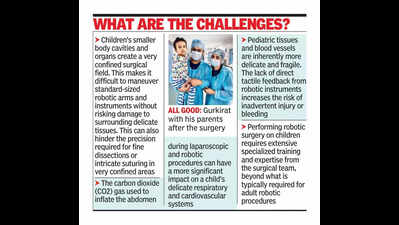Liver transplant using robotic arms gives lease of life to 5-year-old boy | Chennai News – Times of India

Chennai: A five-year-old boy with a rare genetic disorder underwent a successful liver transplant using robotic arms, reducing his recovery time, doctors at Rela Hospitals announced on Thursday. Gurkirat Grover had a urea cycle defect, a condition that impairs his body’s ability to process and remove ammonia, a toxic waste from protein metabolism. Doctors opted for a minimally invasive surgical approach, after which the child was discharged in less than a week, compared to a hospital stay of at least three weeks in traditional open surgery.“The boy is among the youngest recipients of a robotic liver transplant globally,” said Dr Naresh Shanmugam, senior consultant, paediatric gastroenterology and hepatology. Due to the genetic condition, his liver did not function properly, he said. “When we eat protein, our bodies break it down into amino acids. During this process, a byproduct called ammonia is naturally produced. The liver enzymes work together in a biochemical pathway to convert the toxic ammonia into a less harmful substance called urea.This urea is then transported through the bloodstream to the kidneys and excreted from the body in urine. With the condition, Grover’s body couldn’t efficiently convert ammonia into urea,” he said.This led to encephalitis and constant hospitalisations. Grover’s parents had lost their previous child due to the same condition. So, when doctors said a liver transplant was a definitive cure, they instantly agreed. His mother Nikita Kohli, was the donor. Doctors opted for robotic transplants to prevent complications. The donor liver was removed using robotic arms, too. In the patient, the surgical cut was less than 6 cm under the belly button, compared to the 12 cm cut on the belly during conventional surgery.“It’s easy on the child as it reduces blood loss, complications, and expedites recovery,” said hospital chairman Dr Mohamed Rela. “But for a surgeon. paediatric bodies offer far less space than adults. We create more working space inside the abdomen. So, it posed greater challenges for the insertion and manoeuvring of robotic instruments,” he explained. Additionally, doctors opted for an auxiliary liver transplant, where only a portion of a healthy donor liver is implanted into the recipient.Part of the recipient’s original diseased liver was left in place.
















